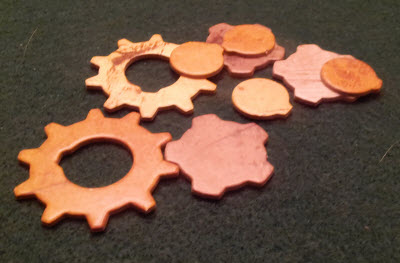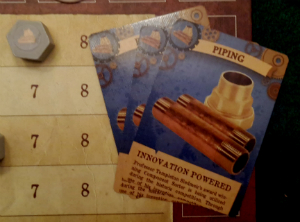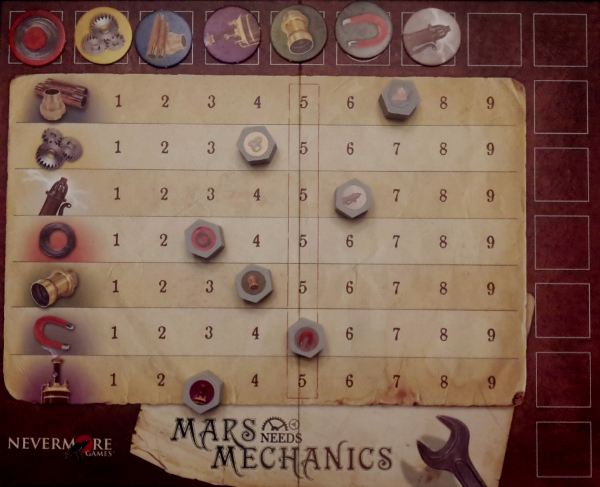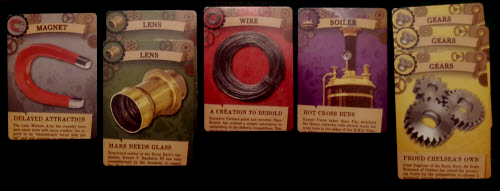History is a fascinating field of study. It allows us to connect to our past, to see where we’ve come from and glimpse the lives of all the people who brought us to this point in time. It lets us reflect on both humanity’s triumphs and its failures, as we continually try to learn more about ourselves. We learn about the the past to better our future, and history is full of amazing stories.
But who can resist the allure of a good alternate history? What if D-Day had failed? What if the North lost the Civil war? What if Fox didn’t actually cancel Firefly after half a season? The possibilities…
Take Victorian England. At the height of the British Empire in the late 1800s, England was doing beyond well. It had territory on almost every continent, from Australia to Africa, India to Canada. It had lots of money, the steam ship, the telegraph, and no one could match their naval or military power. It certainly didn’t hurt to be an Englishman of the Empire during the Pax Britannica.
So, what if, during this time period, they weren’t just content with taking over countries, but they figured out the means to explore space as well?
The Premise
It’s 1873, and the British Royal Academy of Space Exploration is planning an expedition to Mars. They have created a contest for the honor of having one of the seats aboard this great endeavor, and the players are the participants. Players must demonstrate their technical skill and careful resource management better than any of the others in order to be the illustrious one chosen among them.
The Rules
Mars Needs Mechanics is a pretty light steampunk game centered around a marketplace, and setup takes very little time. The main board consists of two tracks for each of the game’s seven component types. The bottom track watches the Market, which depicts the current value of each component. The top track is the Order Line, which monitors the purchase activity of the components each round.
Additionally, the game comes with a stack of Item cards and a stack of Component cards. Items may be chosen or randomly determined, as players see fit, and then several are revealed to be used in that game. Items are special devices that can be constructed throughout the course of the game, and each item provides that player with unique abilities.

39 Cogs! That’s good, right?
To start, each player receives two Scrap Metal cards and three Component cards from the Component deck. Players also each receive 30 Cogs, which are the currency of the game. Lastly, eight more cards from the Component deck are revealed, making up the Market for the round.
The first player is the one who can do the best British accent. (We also suggest honoring the absolute worst too. Equally funny.)
Mars Needs Mechanics is played out over a handful of rounds, which are broken down into player turns. A turn consists of two possible actions. First, the player chooses to either Purchase a component or Pass. Purchasing consists of buying one of the available components from the Market at the current market price and adding it to their hand. Then that component type’s token is moved to the front of the Order Line. By contrast, Passing simply means that the player opts not to purchase an item. (Passing on one turn does not prevent a player from purchasing again in a subsequent turn.)
Second, the player is allowed to Build and/or Break Down one of the special Items in the game if they so choose. However, a player cannot have more than one built item at a time. To Build an item, the player sets aside the components depicted on the Item from their hand and uses a player marker to denote that item is built. The player now has access to the abilities that Item offers. Breaking Down does the opposite: a player removes the token and retrieves the set-aside components.

High quality pipes are worth 21 Cogs.
Players continue taking turns until either all eight components are purchased, or all players Pass consecutively. At that point, the Order Line readjusts the value of the components on the marketplace: the front three component values go up by one, and the last three components go down by one.
Players in turn order have the ability to then sell one or more sets of cards for Cogs. Sets are comprised of at least three of the same type of component and are sold at the market price. (For example, a set of three Magnets, listed at a value of five, awards a player 15 Cogs.) Players may use their Scrap Metal as a component of any type for set making, but Scrap Metal does not get a player any money. When all players are finished selling sets, the marketplace is restocked up to eight cards and the first player rotates.
The game can end when no one purchases items from the marketplace for two full rounds, but the vast majority of the time it will be because the Component deck is empty at the end of a round. At that point, players count up the total value of their Cogs.
The player with the most has displayed their clear mastery of item efficiency over the other contestants. Their reward is to be strapped into a rocket and sent to Mars.
The losers…may have dodged a bullet there.

Market rates after being adjusted.
The Cog Exchange
Mars Needs Mechanics is, by and large, a market manipulation game with some nice steampunk flavor. The objective is to figure out the best course of action during each of your turns, and at first there appears to be little nuance to it. Most players get locked into the singular options of ‘Buy’ or ‘Don’t Buy’, and on initial approach, that is seemingly the only real decision-making the game presents to you.
But the game does have a bit more to it than that. Yes, players buy components and sell them when it’s most convenient, but the way the marketplace works in Mars Needs Mechanics, a massive buying spree is not necessarily the best course of action. It’s entirely possible, for example, to buy up the pair of Lens components you need and still have their value stay the same or drop if enough components are bought afterwards.

Knowing which items to get and when are key.
Contrary to what it may seem, the game operates with thinner margins of victory than it seems. For instance, you’re likely only able to sell sets at a +1 or +2 value compared to when you bought them, which helps create game tension. It also explains why most of the Items have seemingly weak powers at first. It can take some guesswork initially when planning your timing, but knowing when to Pass and when to sell are small but important tactics in a game like this. And the appeal of Mars Needs Mechanics is directly tied to this.
Adjusting For Motivation
In fact, the carefully maneuvering the marketplace is sort of the entirety of the game. Unfortunately in this case, that poses a problem. Most market manipulation games use the marketplace as a means to leverage something towards something else, be it other resources, money, territory, etc.
Mars Needs Mechanics manipulates the market…for the sake of manipulating the market. There is a bit of a disconnect with player agency as a result, as players can easily feel like there isn’t a purpose to what they’re doing. (Immersionists will find this aspect incredibly frustrating.)
Indeed, while the game’s handling of the market mechanic is well done, it inevitably feels like you’re playing the mechanic itself more than a game with the mechanic. Using different Items each session helps add some variety to the gameplay – some of them being quite powerful – but the bulk of the game remains just its singular process.
This also raises the game’s issue of maintaining player engagement. Mars Needs Mechanics operates similarly to classic card games like Gin Rummy. The social interaction in these cases come not from what the game is having the players do, but from the ability to engage with the other players over a communal activity. With Mars Needs Mechanics, you are mostly just trying to collect the right cards to make sets and then sell those sets at the most opportune time; it is pretty straightforward. Its light nature and short play time work in its favor in this regard. Still, beyond a few moves over when to buy cards, little you do has any impact on the other players. Even some of the more combative Item cards only alter people’s strategies so much.
 As a result of these factors, Mars Needs Mechanics has some trouble attracting most archetypes. Socializers are the most likely to enjoy this game, so long as the lack of in-game player engagement is offset by the players themselves. Tacticians are technically the next most likely, as there is just enough depth to manipulating the marketplace into making unexpected moves. That said, the game’s simple nature and inability to see more than a turn ahead makes planning difficult. Don’t expect them to play it all that regularly.
As a result of these factors, Mars Needs Mechanics has some trouble attracting most archetypes. Socializers are the most likely to enjoy this game, so long as the lack of in-game player engagement is offset by the players themselves. Tacticians are technically the next most likely, as there is just enough depth to manipulating the marketplace into making unexpected moves. That said, the game’s simple nature and inability to see more than a turn ahead makes planning difficult. Don’t expect them to play it all that regularly.
The rest are unlikely to get much enjoyment out of the game at all. Strikers could find a way to make the game playable – such as using certain Items to slow opponents down, and most can appreciate the linear path to victory. However, the lengths one must go through in order to affect other players, coupled with the randomness of the Market, will have them seeking other venues. Daredevils and Architects on the other hand have no outlet for their respective interests and are best to skip this game. Daredevils often run into issue with market-based games as they don’t reward unorthodoxy, and this one is no different. Moreover, since you are limited to one Item (usually), the only use for sets of component cards is to turn them in for points, and that’s not the kind of tradeoff that Architects desire.
The Takeaway
Nevermore Games’s follow-up to their inaugural game aimed to be on par with its predecessor. Unfortunately, it doesn’t quite reach that level. On the one hand, Mars Needs Mechanics doesn’t do anything inherently wrong. It’s not a bad game per se – it was clearly designed to be a light affair with a 45 minute play time, and it succeeds at that. It also has some nice physical components, and the flavor is basic but visible. On the other hand, the game doesn’t do anything particularly noteworthy either. The market mechanic certainly works as intended, but it ultimately feels like a missed opportunity for more. Using it towards simple set matching in some ways makes the game seem like it isn’t living up to its own potential. It’s a disconnect that can also cause players to question the purpose of what they’re doing, which diminishes the overall experience and gives off a vibe that makes the game feel incomplete.
In the end, Mars Needs Mechanics shoots for the moon (or Mars), but only really reaches high orbit. It’s still an accomplishment, as it’s perfectly serviceable as a family game or a Gateway Game where you’re looking to teach someone about market-based mechanics in a steampunk-lite world. For many others, it’ll have trouble maintaining long-term interest, as it’s hard to shake the feeling that you’re playing a mechanic more than playing a game.
Mars Needs Mechanics is a product of Nevermore Games.
Cardboard Republic Snapshot Scoring (Based on scale of 5):
Artwork: 3
Rules Clarity: 5
Replay Value: 2
Physical Quality: 4
Overall Score: 2.5

